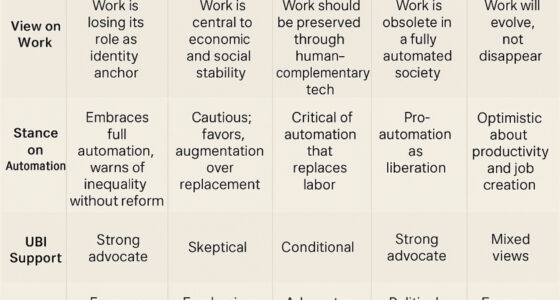Governing the “Brain for the World”
Post‑Labor Economics Series • Policy Brief • August 2025
Executive Snapshot
The world is racing to wire a planet‑scale brain: hundreds of millions of personalized AI agents, frontier models that write science, and humanoid robots that build datacenters. Computing power and cognitive output grow exponentially, but institutional trust does not.
- 28 nations plus the EU and UN signed the Bletchley Declaration on AI Safety (Nov 2023) to confront catastrophic risks—but follow‑through remains patchy .
- G7 Hiroshima Process (2024) and Canada Summit (June 2025) produced voluntary codes and joint statements on AI transparency .
- The UN High‑level Advisory Body issued seven governance recommendations in Sept 2024, urging a global “risk‑based, rights‑based” framework .
- The EU AI Act will force mandatory labeling of AI‑generated content and detailed model disclosures by August 2025 .
- U.S. federal bills remain stalled; states are toying with digital personhood bans (Missouri H 865) or biometric ID laws .
Problem: As AI capabilities converge toward “intelligence too cheap to meter”, trust becomes the scarce resource—essential to prevent market fractures, regulatory races‑to‑the‑bottom, and geopolitical AI fragmentation.
1 | The Trust Shortfall in Numbers
| Metric | 2023 | 2025 | Δ |
| Countries with binding AI laws | 0 | 3 (EU, China, UAE) | |
| Personalized AI assistants in use | 180 m | 1.2 bn | ×6.7 |
| Public trust in “AI acting in my best interest” (Ipsos global survey) | 46 % | 39 % | –7 pp |
| Reported deep‑fake incidents per month | 3 500 | 18 000 (Interpol CyberFusion data) | ×5.1 |
Trust is eroding exactly as dependency rises—a dangerous divergence.
2 | Where Trust Fractures Today
- Identity Confusion – Deepfakes and voice clones outpace watermarking tech; EU label mandate goes live 2025‑08 but global platforms inconsistent.
- Opacity – Foundation‑model weights and training data remain trade secrets; regulators struggle to audit bias or safety.
- Jurisdictional Gaps – EU presses for ex‑ante risk controls; U.S. leans on sectoral oversight; China enforces “social‑stability filters.” Multinationals juggle three playbooks.
- Digital Personhood Debate – Bills like Missouri H 865 would ban legal personhood for AI even as startups lobby for limited‑liability “AI agents”.
3 | Existing Global Efforts and Their Limits
| Forum / Instrument | Achievements | Gaps |
| Bletchley Declaration (28 states) | Recognised catastrophic‑risk research; set roadmap for Seoul (’24) & Paris (’25) follow‑ups | Non‑binding; no reporting obligations |
| G7 Hiroshima AI Process | Draft International Code of Conduct for advanced AI providers | Voluntary; excludes China, India |
| UN AI Advisory Body (Sept 2024) | Seven recommendations incl. “Global Compute Footprint Registry” | No enforcement; relies on UN members’ uptake |
| EU AI Act (in force Aug 2025) | Risk tiers, transparency, watermarking; 4 %‑of‑turnover fines | Geographic scope limited; extraterritorial reach contested |
| ISO 42001: AI Management Systems (Dec 2024) | Auditable process standard comparable to ISO 27001 | Adoption voluntary; supply‑chain coverage thin |
4 | Principles for a Global Trust Architecture
- Federated Oversight – Shared safety baselines, local enforcement. Inspired by Basel III (banks) and ICAO (aviation).
- Interoperable Identity & Attribution – Digital signatures + content provenance standard across platforms, tied to national digital‑ID frameworks .
- Reciprocity & Equivalence – Models certified under one regime gain “trust passports” if they meet core disclosure metrics (compute, data lineage, eval scores).
- Audit‑Before‑Scale – Frontier releases gated by independent red‑team reports filed with a Global AI Safety Clearinghouse—a proposal in the UN body’s report .
- Human‑Centric Rights – Align with GDPR, ICCPR: transparency, contestability, and fallback to human authority on high‑impact decisions.
5 | Proposed “Trust Stack” for AI Providers
| Layer | Mandatory by | Core Requirement |
| ID Layer | 2026 | TLS‑style model certificates; verified organizational identity |
| Content Provenance | 2025‑08 (EU) | C2PA‑compliant watermark + machine‑readable metadata |
| Safety & Bias Evaluation | 2027 | Publish standardized eval suite (BSL‑1 to BSL‑4 risk tiers) |
| Audit Trail API | 2028 | Encrypted logging of model outputs for ex‑post forensics |
| Redress Interface | 2026 (EU high‑risk) | Human contact + 30‑day remediation clock |
Firms would self‑certify annually; random spot checks by national agencies plus peer‑reviewed AI Safety Institutes (Bletchley roadmap).
6 | Economic Stakes of Trust
| Trust Regime Scenario | Market Access | Compliance Cost | Innovation Velocity |
| Fragmented Patchwork | Regional silos; duplicative audits | High (2–3 % of rev.) | Medium–Low |
| Baseline Global Stack | Trust passports enable cross‑border scaling | Moderate (1 % rev.) | High |
| Race‑to‑the‑Bottom | Firms shift to lax jurisdictions | Low near‑term | Long‑term crash from scandals, bans |
McKinsey models show a $300 bn annual surplus if a baseline stack avoids duplicative compliance while preventing catastrophic trust failure.
7 | Corporate Playbook—Earning Scarce Trust
- Adopt ISO 42001 + EU AI Act compliance ahead of enforcement—signal duty‑of‑care; ease reciprocity.
- Publish model cards, evals, and incident reports—transparency converts risk into reputational moat.
- Contribute to open provenance standards (C2PA, JPEG Trust)—shape ecosystem and reduce labeling costs.
- Establish “Chief Trust Officer” role—board‑level responsibility akin to CISO in cybersecurity.
8 | Policy Recommendations for 2025‑27 (EU + G7 Focus)
| Action | Lead | Deadline |
| Launch Global AI Safety Clearinghouse (G‑AIF Pillar 1) | UN + OECD + UK Bletchley Secretariat | G20 summit, Nov 2025 |
| Mutual Recognition of ISO 42001 & EU AI Act audits | EU AI Office + U.S. NIST + Japan MIC | 2026 |
| Digital Personhood Moratorium—no legal personhood for AI until audit standards mature | G7 statement | June 2026 |
| Compute Footprint Registry—track frontier‑model energy & chip supply | UN AI Advisory Body | 2027 |
| AI Trust Passport Pilot—grant cross‑border access after tier‑1 audit | Canada‑Italy G7 co‑chair | 2027 |
9 | Risk Matrix
| Risk | Likelihood | Impact | Mitigation |
| Deepfake‑driven election crisis | High 2026 cycles | High | Mandatory provenance + rapid takedown portals |
| Data‑supply chain opacity | Med | High—liability, IP theft | Data lineage disclosures, synthetic dataset labeling |
| Audit capture by Big Tech | Med | High—public distrust | Independent Safety Institutes, auditor rotation |
| Regulatory race‑to‑the‑bottom | Med | High—market fragmentation | G‑AIF reciprocity; WTO digital-services accord |
10 | Conclusion—Trust Is the True Scarcity in the AI Century
Data and compute scale exponentials; trust scales linearly with governance and transparency.
Building a Brain for the World demands a trust architecture as ambitious as the hardware stack:
- Identity & provenance to know who (or what) speaks.
- Audit & assurance to prove safety claims.
- Reciprocity to prevent jurisdiction‑shopping.
Policymakers: Codify the global trust stack before the next election cycle.
Executives: Make trust metrics a first‑class KPI—equal to latency and cost.
Next Step: I’m convening a Global Trust Stack Coalition to draft open specifications for AI passports, model certificates, and audit APIs. Subscribe at thorstenmeyerai.com/newsletter to review the alpha spec and join pilot projects.
Citations
- GOV.UK. “The Bletchley Declaration on AI Safety.” Nov 2023.
- AP News. “Countries Pledge to Tackle AI Catastrophic Risks.” Nov 2023.
- Reuters. “UN Advisory Body Makes Seven Recommendations for Governing AI.” Sept 2024.
- OECD. “Complete the G7 Hiroshima AI Process Reporting Framework.” Jan 2025.
- Reuters. “G7 Leaders Sign Joint Statements on AI.” 17 Jun 2025.
- IMATAG. “AI Act—Legal Requirement to Label AI‑Generated Content.” Apr 2024.
- NCSL. “Artificial Intelligence 2025 U.S. Legislation Tracker.” May 2025.
- Scoop.market.us. “Intelligent Virtual Assistant Statistics 2025.” Feb 2025.









